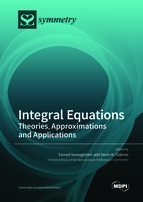Integral Equations: Theories, Approximations and Applications
A special issue of Symmetry (ISSN 2073-8994). This special issue belongs to the section "Mathematics".
Deadline for manuscript submissions: closed (30 June 2021) | Viewed by 28401
Special Issue Editors
2. Department of Applied Mathematics and Programming, South Ural State University, Lenin Prospect 76, 454080 Chelyabinsk, Russia
Interests: numerical analysis; solving integral equations; solving ODEs and PDEs; solving ill-posed problems; fuzzy mathematics; stochastic arithmetic; CADNA library; CESTAC method; solving biomathematical models; iterative methods; numerical methods
Special Issues, Collections and Topics in MDPI journals
Interests: integral equations; machine learning; power systems; inverse problems; MPC; cyber physical systems
Special Issues, Collections and Topics in MDPI journals
Special Issue Information
Dear Colleagues,
We invite you to submit a research paper in the area of integral equations to this Special Issue, entitled “Integral Equations: Theories, Applications, and Approximations”, of the journal Symmetry. We seek studies on new and innovative approaches to exactly or approximately solving the first and second kinds of integral equations in linear and nonlinear forms. We also seek to cover high-dimensional and systems of integral equations. We welcome submissions presenting new theoretical results, structural investigations, new models and algorithmic approaches, and new applications of integral equations.
Prof. Dr. Samad Noeiaghdam
Prof. Dr. Denis N. Sidorov
Guest Editors
Manuscript Submission Information
Manuscripts should be submitted online at www.mdpi.com by registering and logging in to this website. Once you are registered, click here to go to the submission form. Manuscripts can be submitted until the deadline. All submissions that pass pre-check are peer-reviewed. Accepted papers will be published continuously in the journal (as soon as accepted) and will be listed together on the special issue website. Research articles, review articles as well as short communications are invited. For planned papers, a title and short abstract (about 100 words) can be sent to the Editorial Office for announcement on this website.
Submitted manuscripts should not have been published previously, nor be under consideration for publication elsewhere (except conference proceedings papers). All manuscripts are thoroughly refereed through a single-blind peer-review process. A guide for authors and other relevant information for submission of manuscripts is available on the Instructions for Authors page. Symmetry is an international peer-reviewed open access monthly journal published by MDPI.
Please visit the Instructions for Authors page before submitting a manuscript. The Article Processing Charge (APC) for publication in this open access journal is 2400 CHF (Swiss Francs). Submitted papers should be well formatted and use good English. Authors may use MDPI's English editing service prior to publication or during author revisions.
Keywords
- first-kind integral equations
- second-kind integral equations
- Volterra integral equations
- Fredholm integral equations
- linear and nonlinear problems
- singular problems
- ill-posed problems
- systems of integral equations
- high-dimensional integral equations
- convergence analysis
- error analysis
- numerical methods
- analytical methods
- semi-analytical methods







